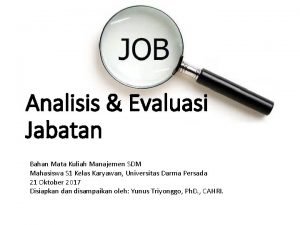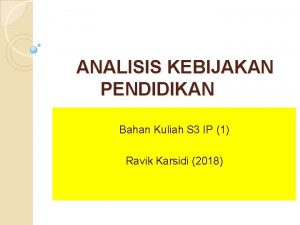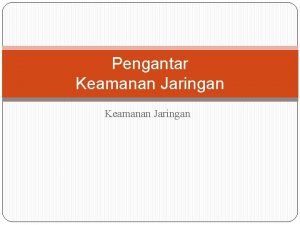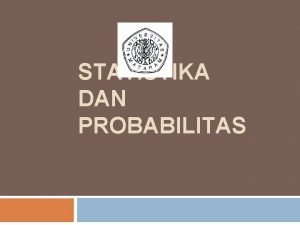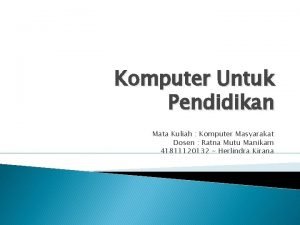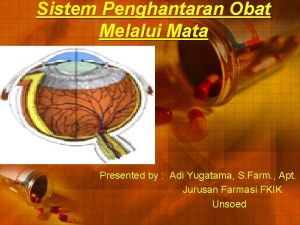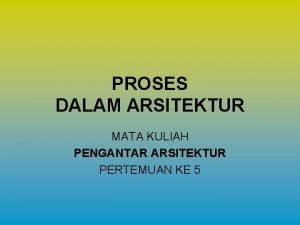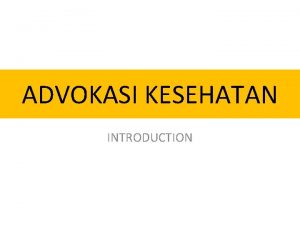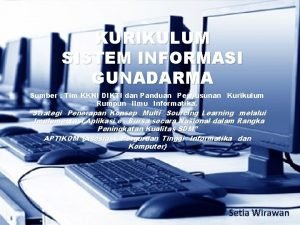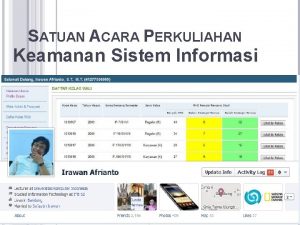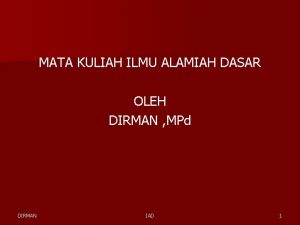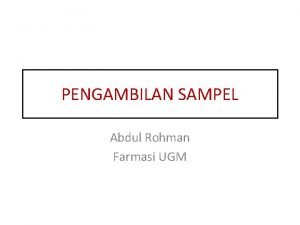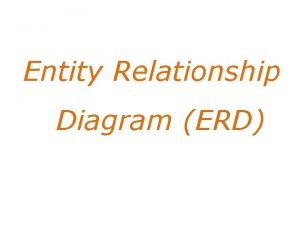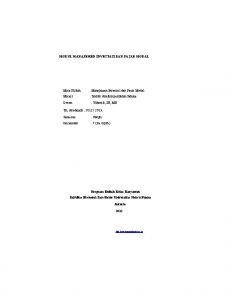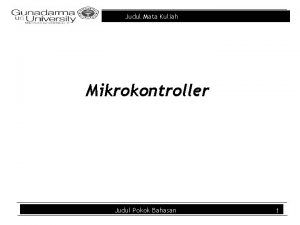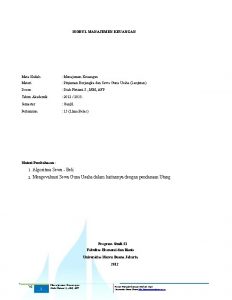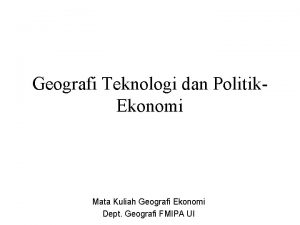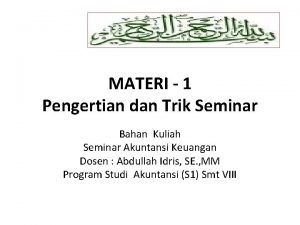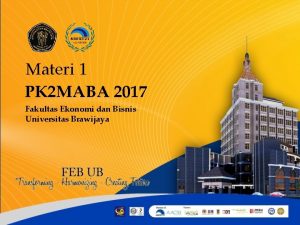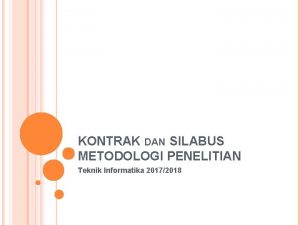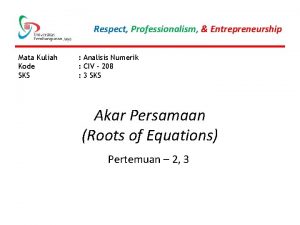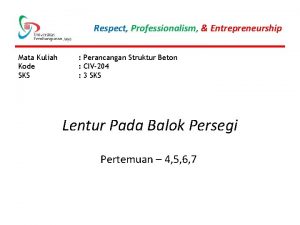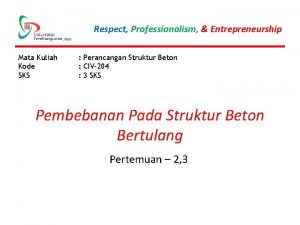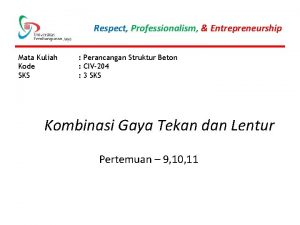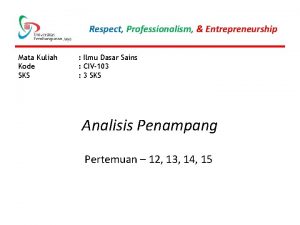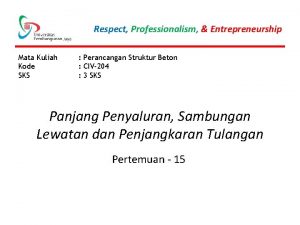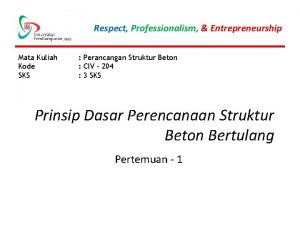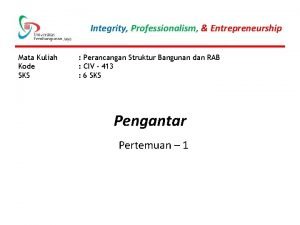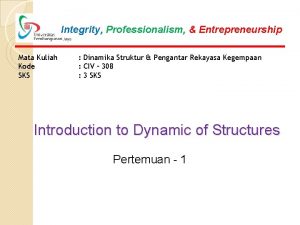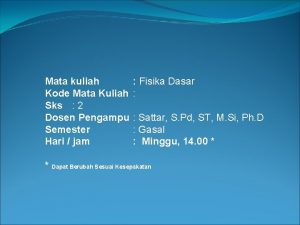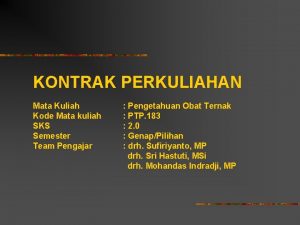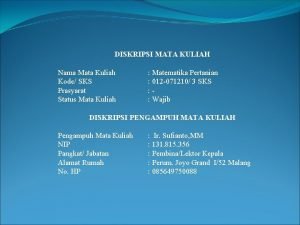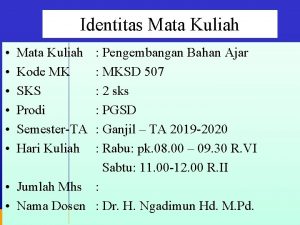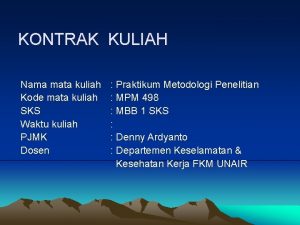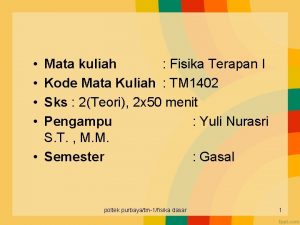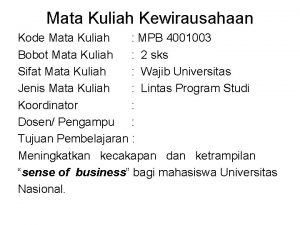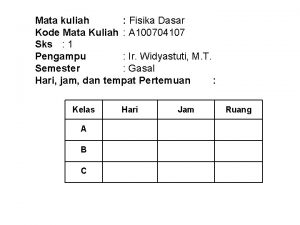Respect Professionalism Entrepreneurship Mata Kuliah Kode SKS Analisis
































- Slides: 32

Respect, Professionalism, & Entrepreneurship Mata Kuliah Kode SKS : Analisis Numerik : CIV-208 : 3 SKS Pengenalan Awal Metode Numerik Pertemuan - 1

Respect, Professionalism, & Entrepreneurship • TIU : Ø Mahasiswa dapat mencari akar-akar suatu persamaan, menyelesaikan persamaan aljabar linear, pencocokan kurva, dan membuat program aplikasi analisis numeriknya • TIK : Ø Mahasiswa dapatmemberikan definisi tentang analisis numerik dan tingkat ketelitian dari perhitungan dengan solusi numerik

Respect, Professionalism, & Entrepreneurship • Sub Pokok Bahasan : ü Definisi metode numerik dan analisis numerik ü Nilai bena, tingkat ketelitian dan error • Text Book : • Chapra, S. , Canale, R. P. (2010). Numerical Methods for Engineers. 6 th ed. Mc Graw Hill, Inc. • Setiawan, A. (2007). Pengantar Metode Numerik. 2 nd ed. Penerbit Andi • Bobot Penilaian : • Tugas • Ujian Tengah Semester • Ujian Akhir Semester : 25 % : 30% : 45%

Respect, Professionalism, & Entrepreneurship What are Numerical Methods? • Techniques by which mathematical problems are formulated so that they can be solved with arithmetic operations {+, -, ×, : } , that can then be performed by a computer.

Respect, Professionalism, & Entrepreneurship Why You Need to Learn Numerical Methods? • During your career, you may often need to use commercial computer programs (canned programs) that involve numerical methods. You need to know the basic theory of numerical methods in order to be a better user. • Numerical methods are extremely powerful problem-solving tools. • You will often encounter problems that cannot be solved by existing canned programs; you must write your own program of numerical methods. • Numerical methods are an efficient vehicle for learning to use computers. • Numerical methods provide a good opportunity for you to reinforce your understanding of mathematics. • You need that in your life as an engineer or a scientist

Respect, Professionalism, & Entrepreneurship Problems to solve in this course f(x) Roots of equations Solve f(x) = 0 for x x f(x) root solution x f(x) Linear algebraic equations a 11 x 1 − a 12 x 2 = c 1 a 21 x 1 + a 22 x 2 = c 2 Solve for x 1 and x 2 Optimization Determine x that gives minimum optimum f(x) x

Respect, Professionalism, & Entrepreneurship Problems to solve in this course f(x) Regression Interpolation Curve fitting: to fit curves to data points. Two types: regressionand interpolation. Experimental results are often of the first type. x x Integration : determination of the area or volume under a curve or a surface. It has many applications in engineering practice. f(x) I x

Respect, Professionalism, & Entrepreneurship The engineering problem solving process

Respect, Professionalism, & Entrepreneurship • A mathematical model is represented as a functional relationship of the form: • Dependent variable: Characteristic that usually reflects the state of the system • Independent variables: Dimensions such as time and space along which the systems behavior is being determined • Parameters : reflect the system’s properties or composition • Forcing functions : external influences acting upon the system

Respect, Professionalism, & Entrepreneurship Example : Newton’s 2 nd law of Motion • States that “the time rate change of momentum of a body is equal to the resulting force acting on it” • The model is formulated as F=ma • F = net force acting on the body (N) • m= mass of the object (kg) • a = its acceleration (m/s 2)

Respect, Professionalism, & Entrepreneurship Formulation of Newton’s 2 nd law has several characteristics that are typical of mathematical models of the physical world : • It describes a natural process or system in mathematical terms • It represents an idealization and simplification of reality (focuses on its essential manifestations). • Finally it yields reproducible results consequently can be used for predictive purposes, e. g. forcing function dependent variable parameter

Respect, Professionalism, & Entrepreneurship • Some mathematical models of physical phenomena may be much more complex. • Complex models may not be solved exactly or require more sophisticated mathematical techniques than simple algebra for their solution. • Example : modeling of a falling parachutist FD is the downward force due to gravity. FU is the upward force due to air resistance

Respect, Professionalism, & Entrepreneurship • A model for this falling parachutist case can be derived by expressing the acceleration as the time rate of change of the velocity (dv/dt) v = terminal velocity (m/s) t = time (s) m = mass of the object (kg) g = gravitational constant c = drag coefficient (kg/s)

Respect, Professionalism, & Entrepreneurship • Finally : • This is a differential equation and is written in terms of the differential rate of change dv/dt of the variable that we are interested in predicting • The exact solution for the velocity of the falling parachutist cannot be obtained using simple algebraic manipulation. • Rather, more advanced techniques such as those of calculus, must be applied to obtain an exact or analytical solution.

Respect, Professionalism, & Entrepreneurship • For example, if the parachutist is initially at rest (v=0 at t =0), calculus can be used to solve the equation for : (1) Independent variable Dependent variable Forcing function Parameters

Respect, Professionalism, & Entrepreneurship • Solution for differential equation cannot always be solved analytically using simple algebraic solution. • The exact solution for differential equation can be solved using calculus or by approximation using numerical methods.

Respect, Professionalism, & Entrepreneurship Example 1 : A parachutist of mass 68, 1 kg jumps out a stationary hot air balloon. Compute velocity prior to opening the chute. The drag coefficient is equal to 12. 5 kg/s. Inserting the parameters into the equation (1) above yields :

Respect, Professionalism, & Entrepreneurship • As mentioned previously, numerical methods are those in which the mathematical problem is reformulated so it can be solved by arithmetic operations. • This can be illustrated for Newton’s second law by realizing that the time rate of change of velocity can be approximated by (2) Remember :

Respect, Professionalism, & Entrepreneurship • Equation (2) is called a finite divided difference approximation of the derivative at time ti. Substitute (2) to (1) give : • Rearranged to yield : (3) this approach is formally called Euler’s method

Respect, Professionalism, & Entrepreneurship Example 2 : Perform the same computation as in Example 1 but use Equation (3) to compute the velocity. Employ a step size of 2 s for the calculation. At the start of the computation (ti =0), the velocity of the parachutist is zero. Using this information and the parameter values from Example 1, Eq. (3) can be used to compute velocity at ti+1=2 s:

Respect, Professionalism, & Entrepreneurship Example 2 : For the next interval (from t =2 to 4 s), the computation is repeated, with the result :

Respect, Professionalism, & Entrepreneurship Approximations and Round-Off Errors • Although the numerical technique yielded estimates that were close to the exact analytical solution, there was a discrepancy, or error, because the numerical method involved an approximation. • Actually, we were fortunate in that case because the availability of an analytical solution allowed us to compute the error exactly. • For many applied engineering problems, we cannot obtain analytical solutions. • Therefore, we cannot compute exactly the errors associated with our numerical methods. • In these cases, we must settle for approximations or estimates of the errors

Respect, Professionalism, & Entrepreneurship • Significant Figure

Respect, Professionalism, & Entrepreneurship • The significant digits of a number are those that can be used with confidence. • They correspond to the number of certain digits plus one estimated digit. • For example, the speedometer and the odometer yield readings of three and seven significant figures, respectively. • For the speedometer, the two certain digits are 48. It is conventional to set the estimated digit at one-half of the smallest scale division on the measurement device. Thus the speedometer reading would consist of the three significant figures: 48. 5. • In a similar fashion, the odometer would yield a sevensignificant-figure reading of 87, 324. 45

Respect, Professionalism, & Entrepreneurship The concept of significant figures has two important implications for our study of numerical methods: 1. As introduced in the falling parachutist problem, numerical methods yield approximate results. We must, therefore, develop criteria to specify how confident we are in our approximate result. One way to do this is in terms of significant figures. For example, we might decide that our approximation is acceptable if it is correct to four significant figures. 2. Although quantities such as π, e, or √ 7 represent specific quantities, they cannot be expressed exactly by a limited number of digits. For example, π=3. 141592653589793238462643. . . Because computers retain only a finite number of significant figures, such numbers can never be represented exactly. The omission of the remaining significant figures is called round-off error.

Respect, Professionalism, & Entrepreneurship • Accuracy. How close is a computed or measured value to the true value • Precision (or reproducibility). How close is a computed or measured value to previously Computed or measured values. • Inaccuracy (or bias). A systematic deviation from the actual value • Imprecision (or uncertainty). Magnitude of scatter. (a) Inaccurate and imprecise; (b) accurate and imprecise; (c) inaccurate and precise; (d) accurate and precise.

Respect, Professionalism, & Entrepreneurship • In numerical methods , we use approximation, to represent the exact mathematical operations. • Numerical error is equal to the discrepancy between the truth and the approximation Et = true value−approximation (4) • where Et is the exact value of the error. • The relative error can also be multiplied by 100 percent to express it as (5) • where εt designates the true percent relative error

Respect, Professionalism, & Entrepreneurship Example 3 : Suppose that you have the task of measuring the lengths of a bridge and a rivet and come up with 9999 and 9 cm, respectively. If the true values are 10, 000 and 10 cm, respectively, compute (a) the true error and (b) the true percent relative error for each case.

Respect, Professionalism, & Entrepreneurship If we cannot solved the problem analytically to get the true value, how to calculate its true error? • We normalize the error to approximate value. • Numerical methods use iterative approach to compute answers. • A present approximation is made on the basis of a previous approximation.

Respect, Professionalism, & Entrepreneurship • Percent relative error, ea (6) • The signs of Eqs. (6) may be either positive or negative. • Often, when performing computations, we may not be concerned with the sign of the error, but we are interested in whether the percent absolute value is lower than a prespecified percent tolerance εs. • Therefore, it is often useful to employ the absolute value of Eqs. (6). • For such cases, the computation is repeated until |εa|< εs

Respect, Professionalism, & Entrepreneurship • It is also convenient to relate these errors to the number of significant figures in the approximation. • It can be shown (Scarborough, 1966) that if the following criterion is met, we can be assured that the result is correct to at least n significant figures.

Respect, Professionalism, & Entrepreneurship Example 4 : • In mathematics, functions can often be represented by infinite series. For example, the exponential function can be computed using Maclaurin series expansion • Estimate the value of e 0, 5. • Add terms until the absolute value of the approximate error estimate εa falls below a pre specified error criterion εs conforming to three significant figures. • Note that the true value is e 0. 5=1. 648721…
 Mata kuliah analisis jabatan
Mata kuliah analisis jabatan Mata kuliah analisis kebijakan pendidikan
Mata kuliah analisis kebijakan pendidikan Soal uas mata kuliah perencanaan pembelajaran
Soal uas mata kuliah perencanaan pembelajaran Jenis ancaman keamanan komputer
Jenis ancaman keamanan komputer Erd perkuliahan
Erd perkuliahan Mata kuliah statistika dan probabilitas
Mata kuliah statistika dan probabilitas Ticcit adalah
Ticcit adalah Mata kuliah sistem penghantaran obat
Mata kuliah sistem penghantaran obat Mata kuliah pengantar arsitektur
Mata kuliah pengantar arsitektur Mata kuliah advokasi
Mata kuliah advokasi Mata kuliah perilaku organisasi
Mata kuliah perilaku organisasi Kurikulum teknik informatika gunadarma
Kurikulum teknik informatika gunadarma Mata kuliah sistem produksi
Mata kuliah sistem produksi Mata kuliah keamanan sistem informasi
Mata kuliah keamanan sistem informasi Materi kuliah ilmu alamiah dasar semester 2
Materi kuliah ilmu alamiah dasar semester 2 Matkul ekonomi islam ub
Matkul ekonomi islam ub Mata kuliah pengantar arsitektur
Mata kuliah pengantar arsitektur Fakultas teknologi industri gunadarma
Fakultas teknologi industri gunadarma Abdul rohman ugm
Abdul rohman ugm Penjelasan tentang erd
Penjelasan tentang erd Mata kuliah manajemen investasi
Mata kuliah manajemen investasi Mata kuliah mikrokontroler
Mata kuliah mikrokontroler Tujuan creative writing
Tujuan creative writing Modul manajemen keuangan
Modul manajemen keuangan Mata kuliah geografi
Mata kuliah geografi Pengertian seminar akuntansi
Pengertian seminar akuntansi Mata kuliah ekonomi pembangunan ub
Mata kuliah ekonomi pembangunan ub Deskripsi mata kuliah sejarah pendidikan islam
Deskripsi mata kuliah sejarah pendidikan islam Siklus manajemen risiko (proses mapping risiko)
Siklus manajemen risiko (proses mapping risiko) Klasifikasi sistem manufaktur
Klasifikasi sistem manufaktur Mata kuliah manajemen proyek sistem informasi
Mata kuliah manajemen proyek sistem informasi Materi kuliah fisika lingkungan
Materi kuliah fisika lingkungan Mata kuliah metode penelitian teknik informatika
Mata kuliah metode penelitian teknik informatika
